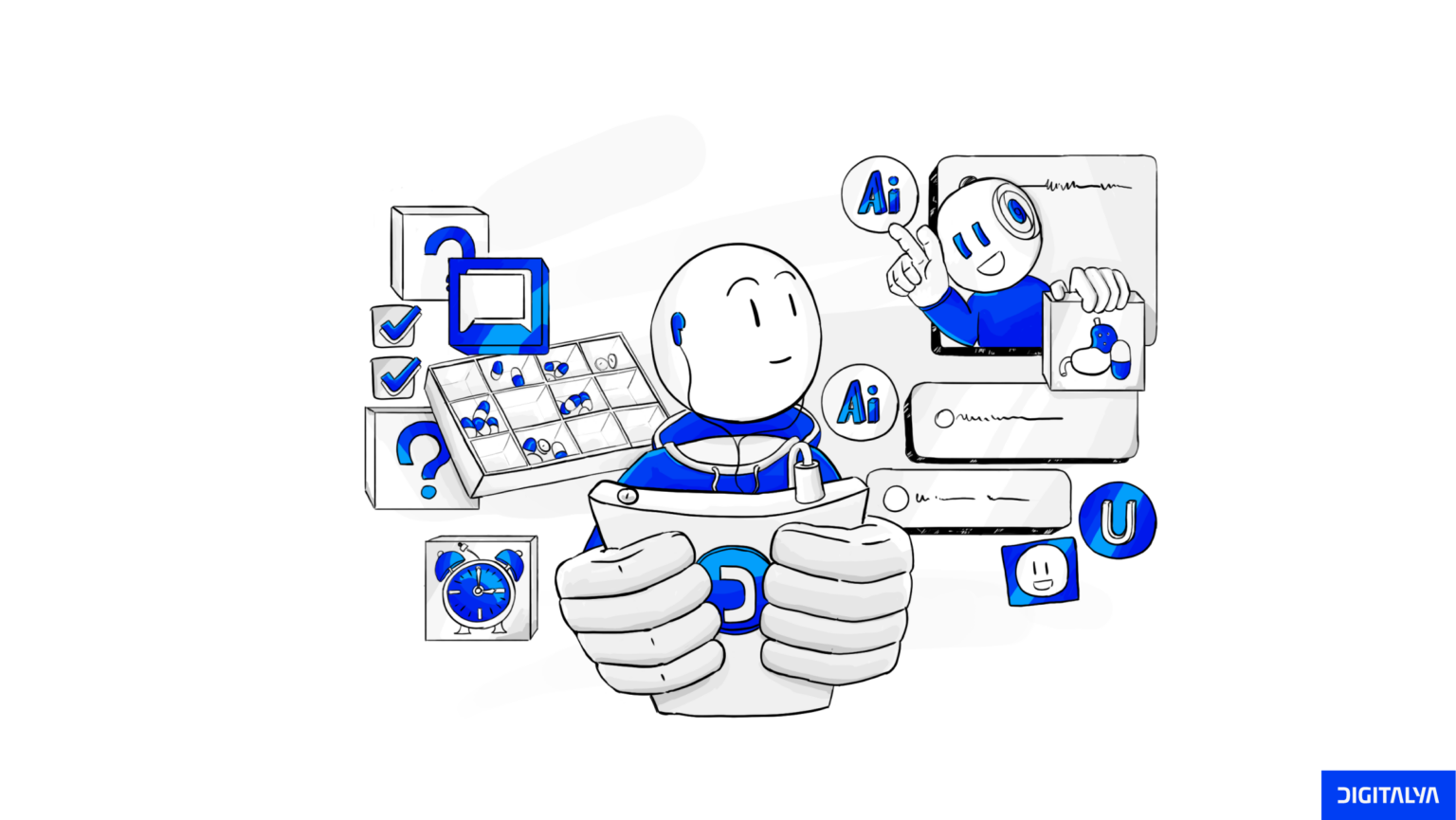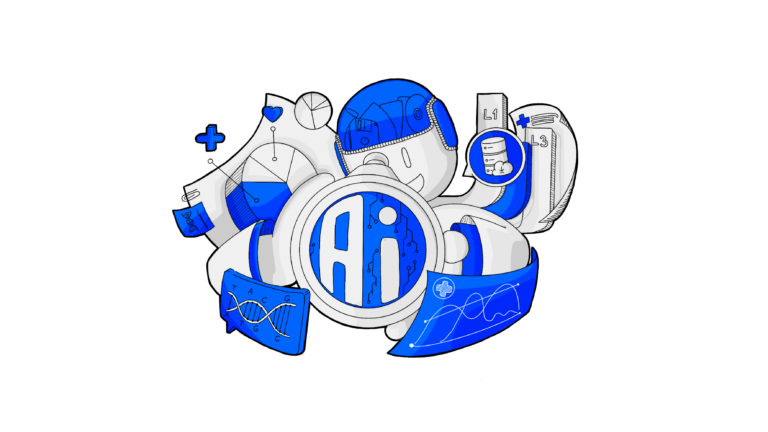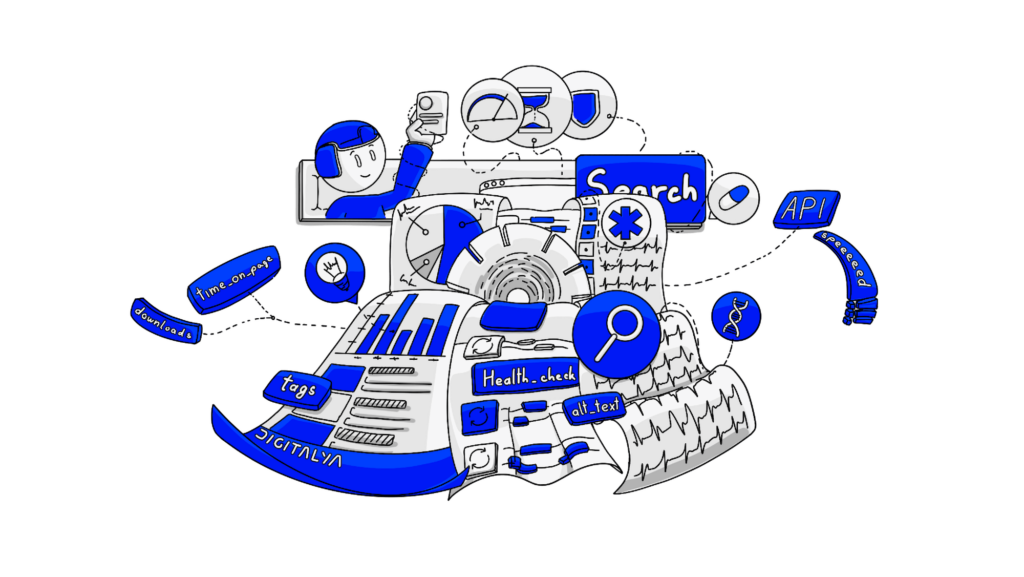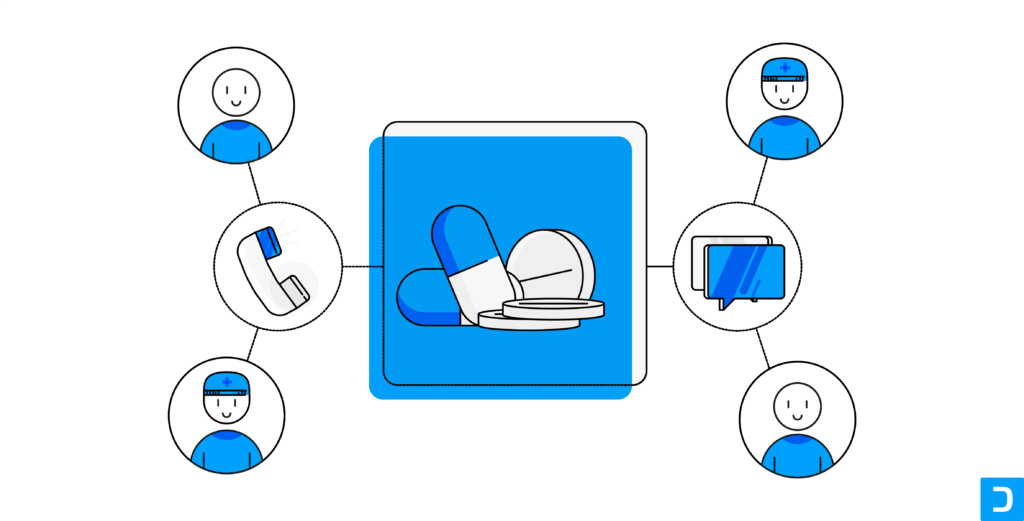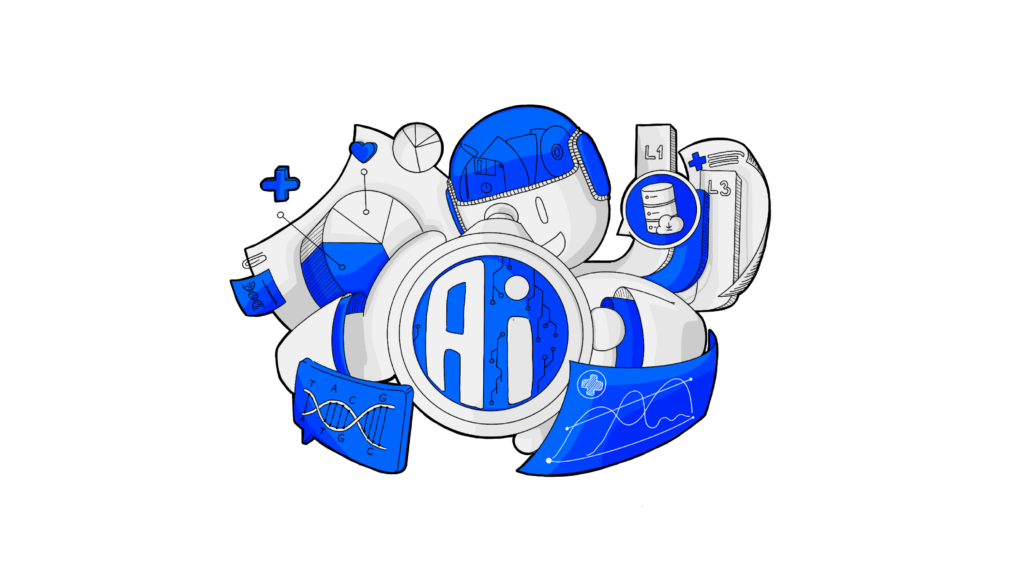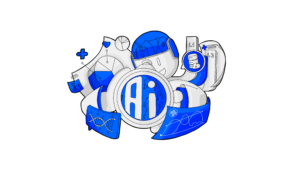1. Introduction
Transformations in the pharma landscape happen at such an accelerated pace that it almost feels like overnight. These changes are no longer about tech gimmicks alone. We’re witnessing a significant shift towards patient-centric care, a relatively new mindset of conducting product development for the pharma industry.
At the forefront of this transformation are pharma companion apps. These innovative digital health solutions are an important leverage to enhance patient engagement with pharma companies and brand loyalty. This industry is increasingly driven by patient needs and behavior, so staying competitive means developing the right patient companion app.
1.1 An overview of pharma companion apps
Digital health solutions increasingly rely on artificial intelligence as the best way to deliver personalized services. This trend is also reflected by the funding landscape. A study by Stanford University revealed that, in 2021, private AI investment in medical and healthcare rose to $11.29 billion, overpassed only by companies dealing with data management and processing, as well as the cloud.
Moreover, as the same study shows, from 2017 to 2021, the medical and healthcare industry saw the greatest overall private investment in AI globally, at $28.9 billion.
Pharma companion apps stand at the intersection of pharmaceuticals and technology, offering a personalized and accessible platform for patients to manage their medications, track their health conditions, and access essential resources.
These apps are not just tools; they represent a fundamental shift toward proactive patient engagement and empowerment in healthcare. Whether it’s an app that can be downloaded to existing smart devices or they come with their own devices, both patients and health institutions become more open to embracing such solutions.
There seems to be a rapid increase in patient-oriented digital tools that are close to obtaining clearance from the FDA and European health organizations. A GlobalData report predicts that, by 20230, the regulated medical apps market is expected to reach $12.1.
1.2 The importance of patient engagement in healthcare
The main objective of developing and prescribing pharma products is to achieve positive health outcomes. However, health improvements don’t automatically result from the development of good healthcare products or very smart digital companions. The patient needs to use it — properly and consistently.
This is why patient engagement plays a pivotal role, including when we talk about sales. It’s still business, isn’t it? Why would you care about it? Pharma companion apps serve as catalysts in fostering this engagement by empowering patients with tools and information to take control of their health.
Engaged patients are more likely to adhere to their treatment plans, leading to better disease management and overall wellness. Also, patients are now increasingly tech-savvy and empowered. They actively seek information and participate in their healthcare decisions. Patients need to be treated as partners in the development of the tools that support their treatment journey.
Additionally, the global market for patient monitoring alone was valued at $48.29 billion in 2022 and is estimated to grow by 7.3% annually, reaching $91.04 billion by 2031.
2. Understanding patient needs
One key challenge for patients is managing their medication regimens. Patients often face difficulties in medication management, including remembering to take their medication on time, understanding dosage instructions, and refilling prescriptions.
Additionally, managing chronic conditions requires continuous monitoring of symptoms and adherence to treatment protocols. Remote patient monitoring tools and medical devices faced an accelerated uptake during the pandemic period and remain a preferred market solution for pharma companies looking to expand.
2.1 Challenges faced by patients in medication management
Patients encounter various challenges in managing their medications. Not only do they simply forget, but they also often get confused about dosage instructions and face difficulty in obtaining refills. These challenges can result in non-adherence, leading to suboptimal treatment outcomes, which leads to increased healthcare costs. Pharma companion apps address these challenges.
A research study conducted in 2023 in Belgium and the Netherlands revealed that “17% of patients with chronic diseases did not pick up their medicines from the pharmacy.” 48% of the polypharmacy patients didn’t have the required medicines, while 31% didn’t have the necessary prescriptions.
Furthermore, the study shows that patients have difficulties understanding the instructions related to their medication, while some didn’t even know the medication name, the dosage, or the indication. There is no surprise, then, that there were indications of problems with organizing the intake of medication timely and correctly.
2.2 The role of companion apps in addressing patient needs
Understandingly, companion apps play a pivotal role in providing patients with convenient and user-friendly solutions for medication management, symptom tracking, and access to educational resources. The simplest way a pharma companion can answer the patient’s need is to help them follow the treatment.
Scheduling, reminders, dosage records, and additional information readily available — these are the “bare necessities” for patients everywhere, regardless of age. Forgetfulness and a distracted mind are no longer the prerequisites of old age alone. Medical devices that offer remote medical assistance, health apps, and wearables that monitor life signs and health metrics and send alerts to caretakers or healthcare professionals – these are just a few examples of how companion apps can address patients’ needs.
The role of pharma companion apps goes beyond the patient’s needs. It can drive systemic change in the healthcare ecosystem and ease the mission of healthcare practitioners. In 2018, a report by the World Healthcare Organization signaled that “one fundamental way that digital health supports primary health care is by improving the ability to gather, analyze, manage and exchange data and information in all areas of health. Digital technologies are being used to improve health information systems from the community level to district, national, and even global levels.” So while it starts with the patient’s needs, the positive effects can have a significant impact at a societal level.
3. Essential features for patient engagement
Effective pharma digital companions go beyond just product information. They act as a comprehensive support system, empowering patients to manage their health actively. Looking at what patients need from a mobile health tool, combined with mechanisms that are known to engage users, here are some critical features that drive patient engagement:
3.1 Medication management tools
This set of features comprises the tools needed to help the patient follow the treatment plan: drug administration schedules, dosage instructions, and prescription refills.
- Reminders and refills — timely alerts for medication intake and refill notifications prevent missed doses and ensure patients stay on track.
- Dosage tracking and instructions — clear visuals and instructions ensure proper medication use, reducing the risk of errors.
- Integrations with pharmacies — seamless refill requests directly through the app enhance patient convenience.
3.2 Condition management tools
Patients with chronic diseases need constant monitoring of health indicators, which alters the quality of life of many people. Many are unaware of something going wrong until they face a crisis; in many cases, it can prove too late. Patient engagement tools that “keep a close eye” on a person’s manifestations of a condition can prove lifesaving. Here are the main features they should have:
- Symptoms tracking and reporting — patients can monitor and record symptoms, providing valuable data for their healthcare providers to adjust treatment plans.
- Educational resources and disease information — easy-to-understand explanations about the condition and treatment options empower patients to make informed decisions.
- Personalized health tips and goal setting — tailored advice and goal-setting tools promote proactive health management, keeping patients engaged in their treatment journey.
3.3 Communication and support features
In addition to medication and condition management tools, companion apps need to offer communication and support features to facilitate interaction between patients and healthcare providers. The easier the communication, the stronger the engagement with the brand. Here are the basic features to drive patient engagement:
- Secure messaging with doctors and pharmacists — facilitates direct communication, fostering a collaborative approach to care and allowing patients to address concerns promptly.
- Telehealth integration for remote consultations — think of a patient education platform that enables remote consultations with healthcare professionals for added convenience and improved access to care, especially for patients in remote locations.
- Community forums and support groups — provide a platform for patients to connect, share experiences, and find support from others facing similar challenges.
4. Additional features to enhance user experience
We’ve discussed the main features of patient care and the treatment journey. To enhance user engagement and patient adherence, companion apps need to be user-centric. This involves additional features that are generally used by other apps, such as gamification, customization, accessibility, and integration.
4.1 Gamification and rewards for adherence
Gamification is a well-known leverage to drive engagement and increase motivation, as was also pointed out in a Deloitte report about the gamified health environment. You can develop a patient companion that integrates points and badges, which will motivate patients to stick to their medication schedules, improving adherence rates and patient outcomes. For instance, the mySugr app uses a system of gaining points to help patients manage diabetes by monitoring their blood sugar levels. The gamified system increased adherence to the app by 85% in a three-month span.
4.2 Personalized medication schedules and insights
People forget. They forget a lot. Not only the elderly but younger persons, too, due to the information bombing we face daily, to which you can add stress at work and daily worries. No wonder people forget to take their medication or go to the doctor for their prescription drug. Personalized reminders and data visualization tools like graphs and charts promote medication adherence and a deeper understanding of treatment progress.
4.3 Data integration with wearable devices
Integrating with wearable health trackers allows for a more holistic view of patient health, providing a more comprehensive picture for informed treatment decisions. In addition, the health data from a pharma companion app can generate valuable insight for a pharma company.
4.4 Accessibility features for diverse users
Catering to users with varying abilities through features like text-to-speech and voice control ensures that patients’ access is inclusive. It allows everyone to benefit from the app’s functionalities, leading to enrolling more users.
5. Design and development considerations
Pharmaceutical companies must also consider several factors to ensure usability, compliance, and security when developing companion apps. These considerations include:
- User-centered design principles
As said before, the app should prioritize user needs. Not only in terms of functionalities but also in how the companion application looks and behaves. For this, you must ensure an intuitive and user-friendly interface that is easy to navigate for patients of all technical backgrounds. Think about the type of health condition your app addresses and the limitations a patient can face when using the app.
- Compliance and regulatory considerations
Adherence to relevant data collection and privacy regulations like HIPAA and security regulations like GDPR is paramount to protecting sensitive patient information. Patient data is a very sensitive issue in the healthcare system, regardless of the country. It means extra attention is needed for both efficacy and safety and protecting the collected data.
- Security and privacy measures
In relation to data insights and privacy regulations, robust security measures like encryption and multi-factor authentication are essential in the development process to protect sensitive patient information and build trust.
- Scalability and interoperability
From the very start, you need to design the app to be scalable to accommodate a growing user base. Consider making it interoperable with other healthcare systems, allowing for seamless data exchange and a more holistic view of patient health, addressing larger patient populations. This can pave the way to entering new markets.
6. Case studies
Several pharmaceutical companies have successfully implemented companion apps to improve patient engagement and health outcomes.
The myGP app is among the UK’s most downloaded medical applications. Almost 2.4 million people use it to track vital signs, set medication reminders, and order prescriptions. As a result, the healthcare system in England has been unburdened by unnecessary appointments, pressure on primary care, and administrative tasks.
Corsano Health’s CardioWatch System, available on the European market, recently obtained FDA clearance, which opens the door for market access in the US. It is a real-time remote patient monitoring system (RPM) consisting of a bracelet and an app, as well as an API and Software Development Kit (SDK) to allow integration with various healthcare systems.
Re-Mission is a particular example of gamification for healthcare purposes. It was developed by HopeLabs and comprises several online games designed for children with cancer to help them cope with the condition and treatment. Studies conducted on patients using Re-Mission showed a positive impact of the game on their emotional state and motivation. This, in turn, correlated to a change in emotions and behavior, leading to a boost in those patients’ adherence to treatment.
7. Conclusion — outlook for the future of pharma companion apps
Digital transformation in pharma has seen the rise of companion apps that have become more interactive and integrated with various health systems. Such digital companions offer a powerful tool to enhance patient engagement with pharmaceutical companies and healthcare professionals.
To drive a high level of patient engagement, pharma companies need to first understand patient needs, then leverage AI technology and incorporate features like gamification and customization. Pharma companies need to aim to empower patients to take control of their health with the help of their digital tools.
However, their success hinges on a collaborative approach. By working together, pharma companies, healthcare providers, and patients can leverage these apps’ potential to transform healthcare delivery, improve patient outcomes, and foster a more patient-centric healthcare ecosystem. As technology continues to advance, the future of pharma companion apps holds promise for further innovation and transformation in patient care.
